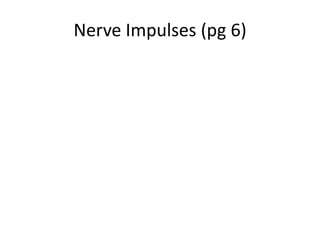
Nerve impulses
- 1. Nerve Impulses (pg 6)
- 2. Nerve Impulses • Nerve cells are able to respond to a stimulus (excitability) and transmit an impulse (conductivity)
- 3. 1. Resting Membrane • K+ is concentrated inside the cell
- 4. Resting Membrane • K+ is concentrated inside the cell • Na+ is concentrated outside the cell
- 5. Resting Membrane • K+ is concentrated inside the cell • Na+ is concentrated outside the cell • Membrane impermeable to passive diffusion of Na+ and K+
- 6. Resting Membrane • K+ is concentrated inside the cell • Na+ is concentrated outside the cell • Membrane impermeable to passive diffusion of Na+ and K+ • The inside of the cell contains more negatively charged ions than the outside
- 7. Resting Membrane • K+ is concentrated inside the cell • Na+ is concentrated outside the cell • Membrane impermeable to passive diffusion of Na+ and K+ • The inside of the cell contains more negatively charged ions than the outside • The inside of the cell membrane is 70 millivolts more negative than the outside
- 8. Resting Membrane • K+ is concentrated inside the cell • Na+ is concentrated outside the cell • Membrane impermeable to passive diffusion of Na+ and K+ • The inside of the cell contains more negatively charged ions than the outside • The inside of the cell membrane is 70 millivolts more negative than the outside • Resting membrane potential = -70 mV
- 9. 2. Depolarizing membrane • A stimulus arrives, making the membrane permeable to Na+
- 10. Depolarizing membrane • A stimulus arrives, making the membrane permeable to Na+ • Na+ rapidly enters the cell, driven by the concentration gradient and the electrical (charge) gradient
- 11. Depolarizing membrane • A stimulus arrives, making the membrane permeable to Na+ • Na+ rapidly enters the cell, driven by the concentration gradient and the electrical (charge) gradient • The inside of the membrane becomes more positive (less polarized)
- 12. 3. Reverse Polarization • So much Na+ enters the cell that the polarity is reversed (positive on the inside, negative on the outside)
- 13. Reverse Polarization • So much Na+ enters the cell that the polarity is reversed (positive on the inside, negative on the outside) • This only lasts for an instant
- 14. 4. Repolarization • Na+ channels close (no Na+ can enter or leave the cell)
- 15. Repolarization • Na+ channels close (no Na+ can enter or leave the cell) • K+ channels open. K+ rapidly leaves the cell, driven by the concentration gradient.
- 16. Repolarization • Na+ channels close (no Na+ can enter or leave the cell) • K+ channels open. K+ rapidly leaves the cell, driven by the concentration gradient. • As K+ leaves, the inside of the cell becomes negative and the outside becomes positive and the membrane is repolarized
- 17. Step E: Moving Ions • The cell pumps Na+ out and K+ in to restore the original condition Na+ Na+ Na+ Na+ Na+ Na+ Na+ K+ K+ K+ K+ K+ K+ K+ Negative charge K+ K+ K+ K+ K+ K+ K+ Na+ Na+ Na+ Na+ Na+ Na+ Na+